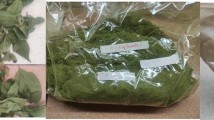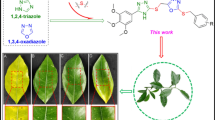Abstract
A series of N,N′-disubstituted thioureas, [R–CONHCSNH–R′] where (R = thiophenyl, furonyl, phenyl and R′ = 4-sulphonamido phenyl, pyrimidine-2yl, thiazole-2yl, 3-nitro phenyl, 2-nitro-4-chloro phenyl, 2-chloro-4-nitro phenyl, 2-methoxy-4-nitro phenyl, and 6-phenyl-1,3,5-triazinyl were synthesized, characterized and screened for their antimicrobial activities. The structures of synthesized compounds were established by elemental analysis and spectroscopic techniques (FT-IR, 1H NMR, and 13C NMR). Single crystal study on compounds 1a and 1c have been done. The compound 1a crystallizes in monoclinic space group Cc, with a = 15.2974(5) Å, b = 11.7766(4) Å, c = 8.1059(3) Å, α = 90°, β = 106.31(3)°, γ = 90° and Z = 4 molecules per unit cell, where as compound 1c crystallizes in orthorhombic space group Pbca, with a = 7.6307(6) Å, b = 11.3895(9) Å, c = 24.121(2) Å, α = β = γ = 90° and Z = 8 molecules per unit cell. All the compounds were tested for their inhibitory activities against four human pathogen bacteria and three fungal strains. The screening data revealed that five compounds showed moderate to good activity whereas one of the compound 1k displayed excellent activity. In vitro hemolytic activity of the compounds has shown them to be nontoxic in nature.
Graphical Abstract
Eleven disubstituted thiourea compounds have been synthesized and characterized by elemental analysis, spectroscopic techniques (FT-IR, 1H NMR, and 13C NMR) and single crystal study on two of compounds has been done to understand the proper structural features of the compounds. All the compounds have been screened for their antimicrobial activity; out of them two have shown promising activity against the bacteria and fungi used.












Similar content being viewed by others
References
Yesilkaynak T, Binzet G, Emen FM, Florke U, Kulcu N, Arslan H (2010) Theoretical and experimental studies on N-(6-methylpyridin-2-yl-carbamothioyl)biphenyl-4-carboxamide. Eur J Chem 1:1–5
Coch RK, Sacht C, Grimmbacher T, Bourne S (1995) New ligands for platinum-group metals: deceptively simple coordination chemistry of N-acyl-N′-alkyl- and N-acyl-N′,N′-dialkyl-thioureas. S Afr J Chem 48:71–177
Gale PA, García-Garrido SE, Garric J (2008) Anion receptors based on organic frameworks: highlights from 2005 and 2006. Chem Soc Rev 37:151–190
Doyle AG, Jacobsen EN (2007) Small-molecule H-bond donors in asymmetric catalysis. Chem Rev 107:5713–5743
Svetlana BT (2007) Recent advances in asymmetric organocatalytic 1,4-conjugate additions. Eur J Org Chem 2007:1701–1716
Sibi MP, Itoh K (2007) Organocatalysis in conjugate amine additions. Synthesis of β-amino acid derivatives. J Am Chem Soc 129:8064–8065
Otazo-Sanchez E, Perez-Marin L, Estevez-Hernandez O, Rojas-Lima S, Alonso-Chamarro J (2001) Aroylthioureas: new organic ionophores for heavy-metal ion selective electrodes. J Chem Soc Perkin Trans 2:2211–2218
Wilson D, de los Ángeles Arada M, Alegret S, del Valle M (2010) Lead(II) ion selective electrodes with PVC membranes based on two bis-thioureas as ionophores: 1,3-bis(N′-benzoylthioureido)benzene and 1,3-bis(N′-furoylthioureido)benzene. J Hazard Mater 181:140–146
Perez H, Mascarenhas Y, Estevez-Hernandez O, Santos S Jr, Duque J (2008) 1-Furoyl-3-methyl-3-phenyl-thio-urea. Acta crystallogr E64:o513–o514
Shen CB, Wang SG, Yang H, Long K, Wang FH (2006) Corrosion and corrosion inhibition by thiourea of bulk nanocrystallized industrial pure iron in dilute HCl solution. Corros Sci 48:1655–1665
Quraishi MA, Ansari FA, Jamal D (2002) Thiourea derivatives as corrosion inhibitors for mild steel in formic acid. Mater Chem Phys 77:687–690
Tang LN, Wang FP (2008) Electrochemical evaluation of allyl thiourea layers on copper surface. Corros Sci 50:1156–1160
Yang D, Chen YC, Zhu NY (2004) Sterically bulky thioureas as air- and moisture-stable ligands for Pd-catalyzed Heck reactions of aryl halides. Org Lett 6:1577–1580
Dai M, Liang B, Wang CH, Chen JH, Yang Z (2004) Synthesis of a novel C 2-symmetric thiourea and its application in the Pd-catalyzed cross-coupling reactions with arenediazonium salts under aerobic conditions. Org Lett 6:221–224
Zhang TY, Allen MJ (1999) An easily prepared, air and moisture stable, resin-bound palladium catalyst for Suzuki cross-coupling reactions. Tetrahedron Lett 40:5813–5816
Saeed S, Rashid N, Hussain R, Ali M, Jones PG (2010) Synthesis, characterization and biological evaluation of some thiourea derivatives bearing benzothiazole moiety as potential antimicrobial and anticancer agents. Eur J Med Chem 45:1323–1331
Manjula SN, Noolvi NM, Parihar KV, Reddy SAM, Ramani V, Gadad AK, Sing G, Kutty NG, Rao CM (2009) Synthesis and antitumor activity of optically active thiourea and their antitumor activity of optically active thiourea and their 2-aminobenzothiazole derivatives: a novel class of anticancer agents. Eur J Med Chem 44:2923–2929
Yoshida M, Hayakawa I, Hayashi N, Agatsuma T, Oda Y, Tanzawa F, Iwasaki S, Koyama K, Furukawa H, Kurakata Y, Sugano Y (2005) Synthesis and biological evaluation of benzothiazole derivatives as potent antitumor agents. Bioorg Med Chem Lett 15:3328–3332
Dharmarajan S, Perumal Y, Murugesan D, Rathinasababathy T (2007) Antimycobacterial activity of novel 1-(5-cyclobutyl-1,3-oxazol-2-yl)-3-(sub)phenyl/pyridylthiourea compounds endowed with high activity toward multidrug-resistant Mycobacterium tuberculosis. J Antimicrob Chemother 59:1194–1196
Pramod CN, Sobhia ME (2008) Quantitative structure activity relationship studies on thiourea nalogues as influenza virus neuraminidase inhibitors. Eur J Med Chem 43:293–299
Yonova PA, Stoilkova GM (2005) Synthesis and biological activity of urea and thiourea derivatives from 2-aminoheterocyclic compounds. J Plant Growth Regul 23:280–291
Xu X, Qian X, Li Z, Huang Q, Chen G (2003) Synthesis and insecticidal activity of new substituted N-aryl-N′-benzoylthiourea compounds. J Fluor Chem 121:51–54
Dodruer D, Urlu S, Onkol T, Ozcelik B, Sahin MF (2010) Synthesis of some pyridazine derivatives carrying urea, thiourea, and sulfonamide moieties and their antimicrobial activity. Turk J Chem 34:57–65
Koca I, Ozgur A, Coskun KA, Tutar Y (2013) Synthesis and anticancer activity of acyl thioureas bearing pyrazole moiety. Bioorg Med Chem 21:3859–3865
Sheldrick GM (2008) A short history of SHELX. Acta Crystallogr A64:112–122
National Committee for Clinical Laboratory Standards (1997) NCCLS approved standard M27-A. Wayne, PA, USA
Tuite J (1969) Plant pathological methods, fungi and bacteria. Burgess Publishing Company, Minneapolis, p 101
Nielson SF, Larsen M, Boesen T, Schonning K, Kromann H (2005) Cationic chalcone antibiotics. Design, synthesis, and mechanism of action. J Med Chem 48:2667–2677
Liu XL, Xu YJ, Go ML (2008) Functionalized chalcones with basic functionalities has antibacterial activity against drug sensitive Staphylococcus aureus. Eur J Med Chem 43:1681–1687
Douglas B, Dains FB (1934) Some derivatives of benzoyl and furoyl isothiocyanates and their use in synthesizing heterocyclic compounds. J Am Chem Soc 56:719–721
Koch KR (2001) N-alkyl- and N,N-dialkyl-N′-acyl(aroyl)thioureas in co-ordination, analytical and process chemistry of the platinum group metals. Coord Chem Rev 216:473–488
Estevez-Hernandez O, Duque J, Perez H, Santos S Jr, Mascarenhas Y (2009) N-(2-Furoyl)-N′-(2-pyridyl)thiourea. Acta Cryst 65E:o929–o930
Yamin BM, Yusuf S, Yusof MSM, Zakaria TNDT (2008) 1-(2-Methyl-benzo-yl)-3-m-tolyl-thio-urea. Acta Crystallogr E64:o1227–o1228
Otazo-Sanchez E, Ortiz-del Toro P, Estevez-Hernandez O, Perez-Marin L, Goicoechea I, Ceron-Beltron A, Villagomez-Ibarra JR (2002) Aroylthioureas: new organic ionophores for heavy metal ion selective electrodes. A nuclear magnetic resonance study. Spectrochim Acta 58:2281–2290
Hoey AJ, Jackson CM, Pegg GG, Sillence MN (1996) Characteristics of cyanopindolol analogues active at the β3-adrenoceptor in rat ileum. Br J Pharmacol 119:564–568
Arslan H, Duron N, Borekci G, Ozer CK, Akbay C (2009) Antimicrobial activity of some thiourea derivatives and their nickel and copper complexes. Molecules 14:519–527
Acknowledgments
The authors sincerely thanks to Prof. Ray J. Butcher, Department of Chemistry, Howard University, 525 College Street NW, Washington, DC 20059, USA, for X-ray data collection. The author Durga Prasad Singh is grateful to BHU for providing UGC-research fellowships. Mr. Mayank Gangwar and Mr. Dharmendra Kumar is thankful to CSIR-New Delhi for providing senior research fellowship.
Author information
Authors and Affiliations
Corresponding author
Rights and permissions
About this article
Cite this article
Singh, D.P., Gangwar, M., Kumar, D. et al. Synthesis, Spectroscopic Characterization, Crystal structure, Antimicrobial and In Vitro Hemolytic Studies of Some Novel Substituted Thiourea Derivatives. J Chem Crystallogr 43, 610–621 (2013). https://doi.org/10.1007/s10870-013-0468-0
Received:
Accepted:
Published:
Issue Date:
DOI: https://doi.org/10.1007/s10870-013-0468-0




